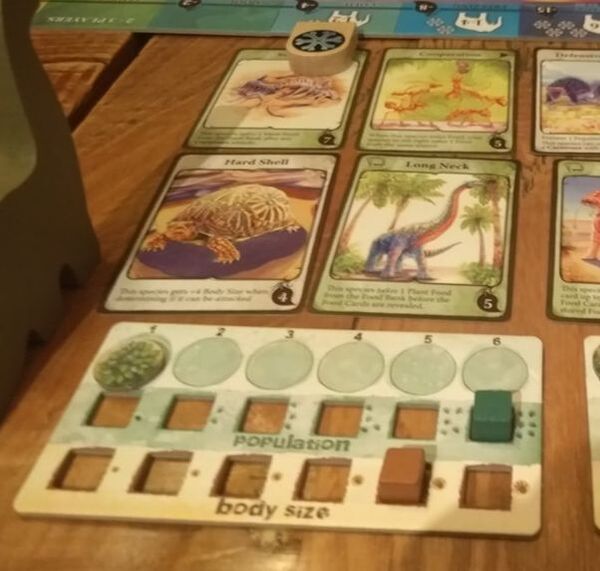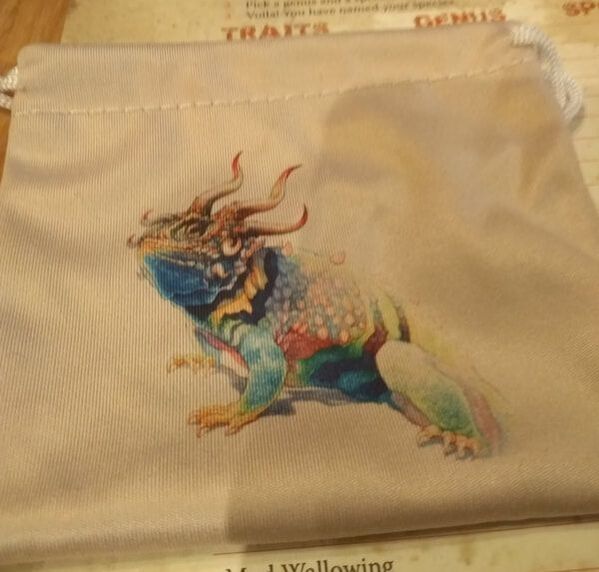|
25th June 2019. Gaming night at 'The Sovereigns' continues. The final game of the night is Evolution: Climate. Have you ever yearned to evolve over millions of years and wander the plains of the Mesozoic era? Do you like dinosaurs (And who doesn't?)? Then maybe Evolution: Climate is for. Evolution: Climate is one in a series of 'Evolution' games about evolving dinosaurs. I've only played this one and they appear to share similar mechanics and concepts, but have differing themes. As the name implies, this game is about climate and adds extra rules for temperature. What's in a game? Evolution: Climate has both a main game board and smaller personal 'species' game boards for all players. The main game board is used to track the climate and food supplies. The personal board is used to track the evolutionary development of your dinosaur species. You can have more than one species during a game and therefore can have more boards. There is a deck of 'trait' cards. Some food markers. Finally, there are some little bags given out to all players. Each bag has a unique dinosaur picture on it, which is a nice touch. How's it play?
Each player is given a species board and a bag. Deal cards. In the first phase, trait cards are dealt to each player, the more species they control, the more cards they get. Determine plant food & climate. In the next phase; play begins with everybody playing trait card face-down on to the main game board. Once this is done, all the cards are turned over. This determines 2 things.
Play trait cards. Players place face-down trait cards next to their species boards. When all players have done, these are turned over. Trait cards represent the different evolutions that your species' will go through. Thus your species' may gain a 'hard shell' or gain the ability to climb. All of these traits give a species special abilities or possibly bonuses to their 'stats'. species can only have 4 different trait cards at any time, but trait cards can be replaced by other trait cards. Players may also discard trait cards to improve their species' 'stats' on their species' boards. Talking of which... The species board has 3 pertinent stats.
Finally, a trait card can be discarded to gain a new species board (And thus begin a new species.). Feeding. This is the final phase of a turn. At the start of this phase all species are hungry and must feed, one at a time. All animals are either herbivore or carnivore.
After feeding has been completed, all players take the food tokens that they have acquired during the round from their species' boards and places the tokens into their spiffy little individual bags. Then the next turn begins with dealing out cards again. Endgame When there are no more trait cards to deal out, the endgame is triggered. Play continues for the current turn and then scores are tallied. A player's score is equal to the food tokens collected in their bag plus the combined value of the population and body size scores of all their species. Highest score wins. Overall One of the things i like about Evolution: Climate is how through some simple rules it depicts the rudimentary theories behind evolution. It's almost educational. At the start of a round, players get the chance to try and influence the available plant food and the climate. These are important decisions as larger dinosaurs fare better in the cold and vice versa in the heat. Also; If your species is herbivorous, you will want to increase the plant food supply and so on. At its core, this an engine-building game, with the trait cards for your species' being the engine. Trait cards make a big difference to a species' ability to fend off predators or to be a better hunter or to more efficiently collect food and so on. There's lots to think about and decisions to make here. Trait cards also count as currency if you want to 'buy' improvements to your species' stats, you use trait cards to do it. This provides with even more decisions to make. Both stats are important. Population is important, increasing it is a good way to stave off the risk of extinction, but it can be hard to maintain if food is sparse. This applies to carnivores too. A carnivore species may not be at the mercy of the limited food on the main game board. But if it wipes out it's food source, it can starve itself into extinction just as quick as any herbivore. Body size is important too. Larger species' will be protected from smaller carnivores and for carnivores size is vital. If a carnivore is not bigger than any herbivores, then that carnivore is in trouble. Feeding can also be quite interesting, as the appearance of a carnivore can really change things up can add a bit of direct conflict to the 'survival of the fittest'. Players must balance all of these concerns during the game, it's not complicated, but it does give players choices and consequences to overcome. This is always a sign of a good game IMHO. I enjoyed Evolution: Climate and would happily play it again.
0 Comments
Leave a Reply. |
AuthorI play, I paint. Archives
March 2024
Categories
All
|



 RSS Feed
RSS Feed
